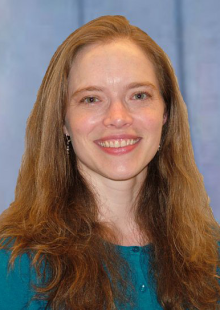
ABOUT
Valeria Tohver Milam joined the School of Materials Science and Engineering at Georgia Institute of Technology as an assistant professor in July 2004. She received her B.S. in Materials Science and Engineering with Honors from the University of Florida in 1993. After completing her M.S. degree (1997) in MSE at the University of Illinois, Urbana-Champaign, she interned at Sandia National Laboratories. She then completed her doctoral work at UIUC studying the phase behavior, structure and properties of nanoparticle-microsphere suspensions. Experimental results suggested a novel colloidal stabilization mechanism known as nanoparticle “haloing” in which otherwise negligibly charged microspheres become effectively charge-stabilized by their surrounding shell of highly charged nanoparticles.
After finishing her Ph.D. in 2001, her postdoctoral studies at the University of Pennsylvania focused on DNA-mediated colloidal assembly. The degree of specific attraction between DNA-grafted microspheres was found to vary with sequence length, sequence concentration and ionic strength. A variety of structures such as colloidal chains, rings and satellites were formed by varying the particle size ratio and suspension composition.
PUBLICATIONS & PATENTS
- M.J.N. Tapp, J.M. Slocik, P.B. Dennis, R.R. Naik, V.T. Milam, “Competition-enhanced ligand selection to identify DNA aptamers.” ACS Comb. Sci. 2018 20 (10) 585-593
- V.T. Milam, “Oligonucleotide-based recognition in colloidal systems – opportunities and challenges,” Current Opinion in Colloid & Interface Science, 2016 26 75-83 (Invited Review)
- A.B. Dunaway, R.S. Sullivan, K.J. Siegel, V.T. Milam, “Evaluating the dual target binding capabilities of immobilized aptamers using flow cytometry,” Biointerphases, 2015 10 (1) 019015
- B.A. Baker, G. Mahmoudabadi, V.T. Milam, “Strand displacement in DNA-based materials systems,” Soft Matter, 2013 9 (47) 11160-11172 (Featured as 2013 “Hot Paper” by Soft Matter)
- J.O. Hardin, V.T. Milam, “Measuring in situ primary and competitive DNA hybridization activity on microspheres,” Biomacromolecules 2013 14 (4) 986-992
- N.A. Eze, V.T. Milam, “Exploring locked nucleic acids as a bio-inspired materials assembly and disassembly tool,” Soft Matter 2013 9 (8) 2403-2411 (Featured on Inside Front Cover)
- B.A. Baker, V.T. Milam, “Hybridization kinetics between immobilized double-stranded DNA probes and targets containing embedded recognition segments,” Nucleic Acids Research 2011 39 (15) e99
- C.K. Tison, V.T. Milam, “Reversing DNA-mediated adhesion at a fixed temperature,” Langmuir 2007 23 (19) 9728-9736
- V.T. Milam, A.L. Hiddessen, J.C. Crocker, D.J. Graves, D.A. Hammer, “DNA-driven assembly of bidisperse, micron-sized colloids” Langmuir 2003 19 (24) 10317-10323
- V. Tohver, J.E. Smay, A. Braem, P.V. Braun, J.A. Lewis, “Nanoparticle halos: A new colloidal stabilization mechanism,” Proc. Natl. Acad. Sci. USA 2001 98 (16) 8950-8954 (Featured on Cover)
EDUCATION & AWARDS
- B.S. Materials Science & Engineering, University of Florida (1993)
- M.S. Materials Science & Engineering, University of Illinois, Urbana-Champaign (1997)
- Ph.D. Materials Science & Engineering, University of Illinois, Urbana-Champaign (2001)
- Summer Faculty Fellow at AFRL (2009)
- NSF CAREER (2009)
- CETL-BP Junior Faculty Teaching Award (2008)
- Georgia Cancer Coalition Distinguished Cancer Scholar (2005)
- Lockheed Martin Aeronautics Company Dean's Award for Teaching Excellence (2005)
RESEARCH INTERESTS
DNA-based ligands for molecular, macromolecular and mesoscale targets
DNA-based ligands called aptamers are functionally similar to antibodies, but have several advantages. These advantages include easier screening and handling procedures, longer shelf-life, and a richer range of both biological and nonbiological target species. The Milam group has developed a nonevolutionary screening platform called CompELS (Competition-Enhanced Ligand Selection) to efficiently identify aptamer “winners” from billions of candidate sequences. Patterns in sequence segments and secondary structures are analyzed among these winners using a variety of computational tools. Ultimately, the goal is to employ these functional oligonucleotides for a variety of applications ranging from highly specific capture agents in sensor and therapeutic systems to macromolecular “reagents” in materials processing.
Bio-inspired colloidal assembly for multifunctional drug delivery vehicles and colloidal-based sensing
The specific recognition between matching or complementary oligonucleotides allows for programmable adhesion between complementary particle surfaces. To program reversible adhesion events under isothermal conditions, the Milam group has explored a variety of natural and unnatural oligonucleotides to serve exchangeable partner strands. Using a variety of biocompatible and biodegradable materials as the colloidal substrate, these biocolloids can serve as building blocks to fabricate novel material constructs ranging from stimuli-responsive hybrid materials to therapeutic delivery vehicles.